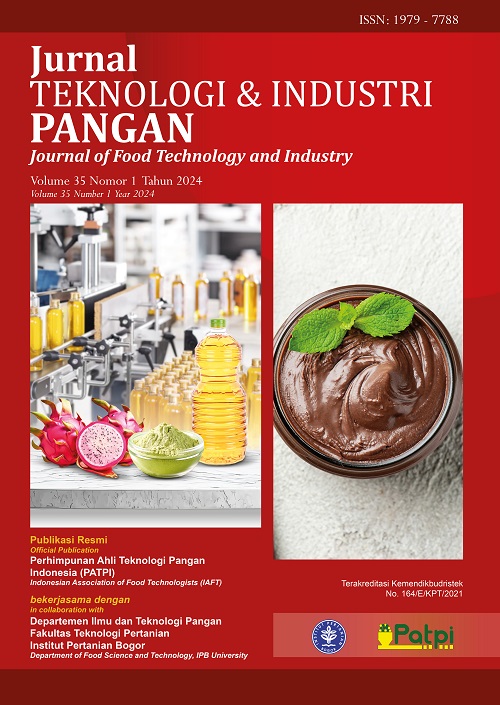Assessment of Sensory Attributes in White Tea Utilizing the High Identity Traits (HITS) Methodology Employing an Immersive Approach
Abstract
White tea is a plant-derived product from Camellia sinensis L, which is processed without enzymatic oxidation and fermentation. The high identity traits (HITS) is a sensory evaluation method that identifies dominant attributes using five attributes to describe each sample. The sensory evaluation research on white tea uses the HITS method with an environmental approach aimed at identifying dominant attributes of white tea using both trained and untrained panelists, as well as at determining the intensity of these dominant attributes using an environmental approach with both trained and untrained panelists. The materials used were five samples of Gamboeng white tea, Heizl, Dandang, Pucuk, and Ennie1. The HITS method with trained panelists successfully identified dominant attributes as follows: yellow-brown brew color, rose aroma, rose flavor, astringent aftertaste, and light mouthfeel. Meanwhile, the experiment using untrained panelists showed dominant attributes as follows: yellow-brown brew color, jasmine aroma, jasmine flavor, astringent aftertaste, and light mouthfeel. The HITS method with an immersive approach for both trained and untrained panelists had an impact on increasing the intensity of aroma, flavor, and mouthfeel while decreasing the intensity of aftertaste.
References
Anuraga, G. (2015). Analisis biplot untuk pemetaan karakteristik kemiskinan pada Kabupaten/Kota di Jawa Timur. J Statistika: Jurnal Ilmiah dan Teori Aplikasi Statistika, 7(1), 25–34. https://doi.org/10.36456/jstat.vol7.no1.a187
Arina, Y., Shiyan, S., & Suprayetno, S. (2022). Analisis kemometrik ekstrak akar tunjuk langit (Helminthostachys zeylanica (L)) melalui analisis fourier transformed infrared dari berbagai daerah Sumatera Selatan. Jurnal'Aisyiyah Medika, 7(1), 243–258. https://doi.org/10.36729/jam.v7i1.790
Belusso, A. C., Nogueira, B. A., Breda, L. S., & Mitterer-Daltoe, M. L. (2016). Check all that apply (CATA) as an instrument for the development of fish products. Food Science and Technology, 36, 275–281. https://doi.org/10.1590/1678-457X.0026
[BSN] Badan Standardisasi Nasional. (2006). Syarat Nasional Indonesia tentang petunjuk pengujian organoleptik dan/atau sensori (SNI 01-2346: 2006). Jakarta: Badan Standardisasi Nasional.
Chen, Y., Huang, A. X., Faber, I., Makransky, G., & Perez-Cueto, F. J. (2020). Assessing the influence of visual-taste congruency on perceived sweetness and product liking in immersive VR. Foods, 9(4), 465. https://doi.org/10.3390/foods9040465
Chueamchaitrakun, P., Adawiyah, D. R., & Prinyawiwatkul, W. (2018). Understanding Indonesian people: Consumer acceptance and emotions study of green tea products from Thailand. Current Applied Science Technology, 18(1), 37–44.
Cicone M. (2019). Differentiation of potato samples using a modified high identity traits (HITS) method is greater with trained panels than untrained. [Thesis]. Kansas: Food Science College of Agriculture, Kansas State University.
Colla, K., Keast, R., Mohebbi, M., Russell, C. G., & Liem, D. G. (2023). Testing the validity of immersive eating environments against laboratory and real life settings. Food Quality and Preference, 103, 104717. https://doi.org/10.1016/j.foodqual.2022.104717
Fadhilah, Z. H., Perdana, F., & Syamsudin, R. A. M. R. (2021). Telaah kandungan senyawa katekin dan Epigalokatekin Galat (EGCG) sebagai antioksidan pada berbagai jenis teh. Jurnal Pharmascience, 8(1), 31–44. https://doi.org/10.1016/j.foodchem.2021.130257
Giezenaar, C., & Hort, J. (2021). A narrative review of the impact of digital immersive technology on affective and sensory responses during product testing in digital eating contexts. Food Research International, 150, 110804. https://doi.org/10.1016/j.foodres.2021.110804
Hadiansyah, F., Hunaefi, D., Yuliana, N. D., Fuhrmann, P., Smetanska, I., & Yasuda, S. (2023). Sensory profiling of indonesian white tea using quantitative descriptive analysis. Jurnal Teknologi dan Industri Pangan, 34(2), 179–186. https://doi.org/10.6066/jtip.2023.34.2.179
[ISO] International Organization for Standardization. (2012). ISO 8596. Sensory Analysis-General Guidelines for the Selection, Training and Monitoring of Selected Assessors and Expert Sensory Assessors. International Organization for Standarization.
Leslie, P. J., & Gunawan, S. (2019). Uji fitokimia dan perbandingan efek antioksidan pada daun teh hijau, teh hitam, dan teh putih (Camellia sinensis) dengan metode DPPH (2, 2-difenil-1-pikrilhidrazil). Tarumanagara Medical Journal, 1(2), 383–388.
Picket, B., & Dando, R. (2019). Environmental immersion’s influence on hedonics, perceived appropriateness, and willingness to pay in alcoholic beverages. Foods, 8(2), 42. https://doi.org/10.3390/foods8020042
Pérez-Burillo, S., Giménez, R., Rufián-Henares, J. A., & Pastoriza, S. (2018). Effect of brewing time and temperature on antioxidant capacity and phenols of white tea: Relationship with sensory properties. Food Chemistry, 248, 111–118. https://doi.org/10.1016/j.foodchem.2017.12.056
Seo, H. S. (2020). Sensory nudges: The influences of environmental contexts on consumers’ sensory perception, emotional responses, and behaviors toward foods and beverages. Foods, 9(4), 509. https://doi.org/10.3390/foods9040509
Sinesio F, Saba A, Peparaio M, Civitelli ES, Paoletti F, Moneta E. 2017. Capturing consumer perception of vegetable freshness in a simulated real life taste situation. Food Research International, 105, 764–771. https://doi.org/10.1016/j.foodres.2017.11.073
Stelick, A., Penano, A. G., Riak, A. C., & Dando, R. (2018). Dynamic context sensory testing–A proof of concept study bringing virtual reality to the sensory booth. Journal of Food Science, 83(8), 2047–2051. https://doi.org/10.1111/1750-3841.14275
Talavera‐Bianchi, M., Chambers Iv, E., & Chambers, D. H. (2010). Describing flavor using fewer and simpler “HITS” (High Identity Traits) profiling: An example with cheese. Journal of Sensory Studies, 25(4), 481–493. https://doi.org/10.1111/j.1745-459X.2010.00281.x
Torrico, D. D., Sharma, C., Dong, W., Fuentes, S., Viejo, C. G., & Dunshea, F. R. (2021). Virtual reality environments on the sensory acceptability and emotional responses of no-and full-sugar chocolate. LWT, 137, 110383. https://doi.org/10.1016/j.lwt.2020.110383
Umar, A. H., Syahruni, R., Burhan, A., Maryam, F., Amin, A., Marwati, & Masero, L. R. 2016. Determinasi dan analisa finger print tanaman Murbei (Morus alba Lour) sebagai bahan baku obat tradisional dengan metode spektroskopi FT-IR dan kemometrik. Pharmacon: Jurnal Ilmiah Farmasi, 5, 78–90. https://doi.org/10.35799/pha.5.2016.11227
Wang, Q., & Spence, C. (2018). “A sweet smile”: the modulatory role of emotion in how extrinsic factors influence taste evaluation. Cognition and Emotion, 32(5), 1052–1061. https://doi.org/10.1080/02699931.2017.1386623

